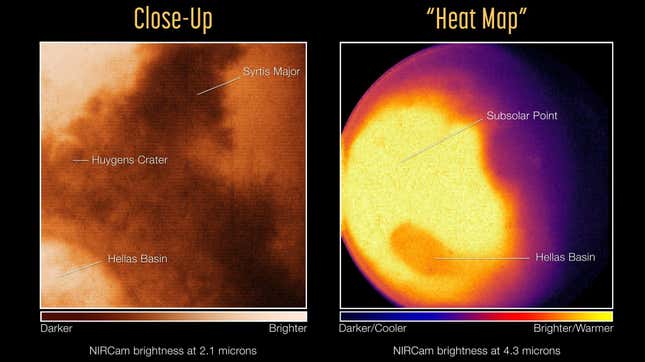
The Webb Space Telescope has amazed us with pictures of distant galaxies and glittering nebulae, but now it’s returned its first images of our solar system neighbor Mars. The newly released data comes from the telescope’s infrared instruments and provides scientists with information about Mars’ surface and atmospheric composition.
The European Space Agency announced today that the Webb Space Telescope caught its first glimpse of Mars on September 5 using the Near-Infrared Camera and Near-Infrared Spectrograph. This first view of Mars from the telescope is actually made up of two images taken at two infrared wavelengths. It shows the sun-soaked Eastern Hemisphere of the planet, which Webb observed from its vantage point nearly 932,000 miles (1.5 million kilometers) away at Sun-Earth Lagrange Point 2.

The first image (top right in the above graphic) shows a view of Mars in 2.1 microns, while the second (bottom right) was taken in 4.3 microns—both wavelengths that correspond to the near infrared spectrum, which is not visible to the human eye.
Webb also collected some spectroscopic data on the Martian atmosphere using the Near-Infrared Spectrograph. The spectrograph reveals some of the molecules that make up Mars’ incredibly thin atmosphere, including carbon dioxide, water, and carbon monoxide, which correspond to the highlighted dips in the graph. While this isn’t a groundbreaking conclusion, it does show Webb’s ability to accurately characterize the atmospheric composition of different planets.
“These first Webb observations of Mars demonstrate how we can study the different regions on its surface, including the composition of its atmosphere with the NIRSpec instrument,” said Chris Evans, a Webb project scientist for ESA, in an email to Gizmodo. “Building on what’s been done with other missions, and without the limitations of Earth’s atmosphere for ground-based spectroscopy, Webb will give us new insights into important topics such as the history of water on Mars.”

By pointing Webb’s gaze at a well-studied planet like Mars, scientists can establish how reliable the high-tech telescope is at studying very distant celestial bodies. As Webb continues to set its sights on objects clear across the universe, we’re still excited to get new views of our cosmic backyard, like the recent view of a glowing Jupiter and its auroras.
Update September 19, 1:20 pm ET: This article was updated to include quotes from Chris Evans, a Webb project scientist at ESA.